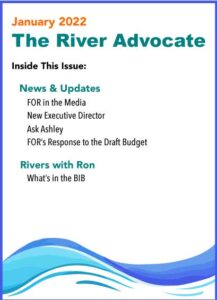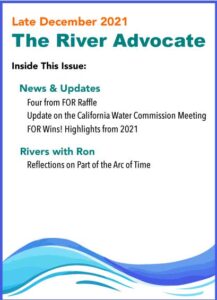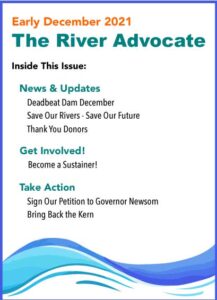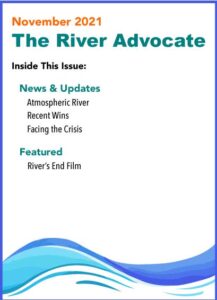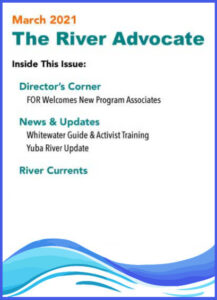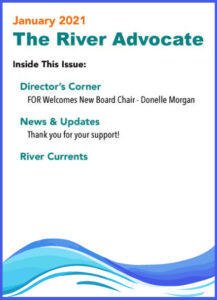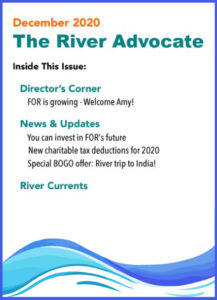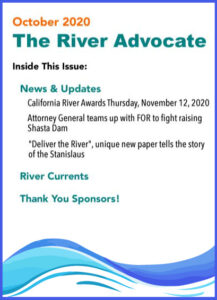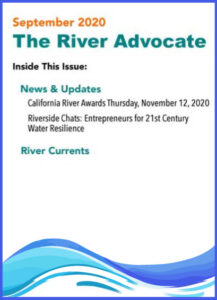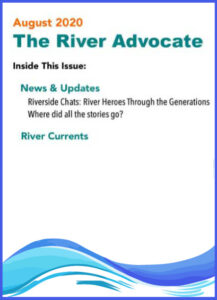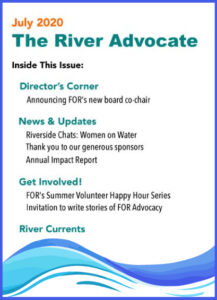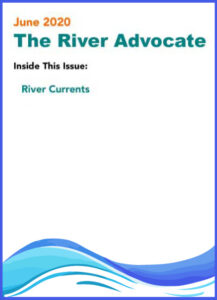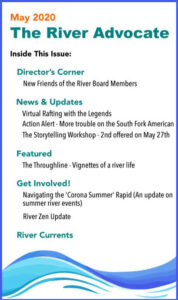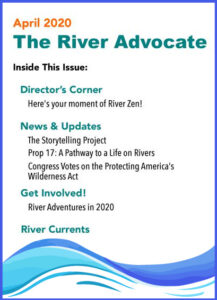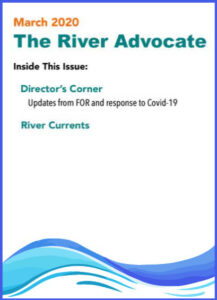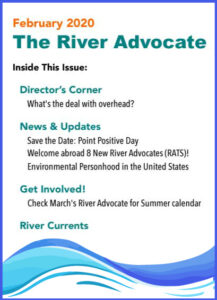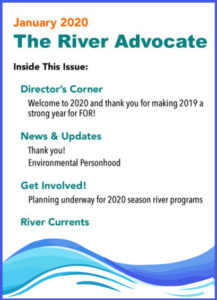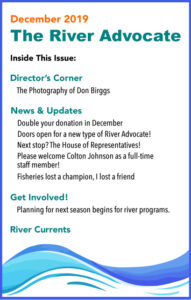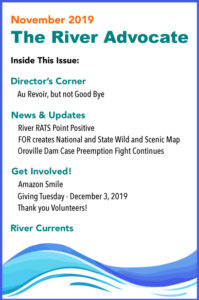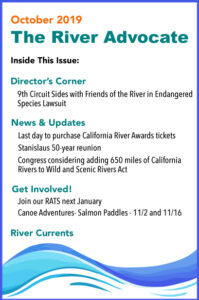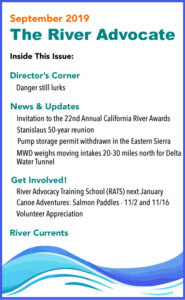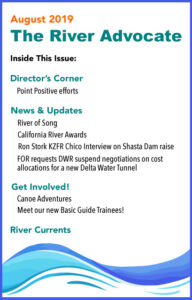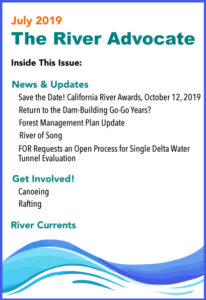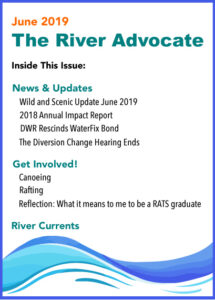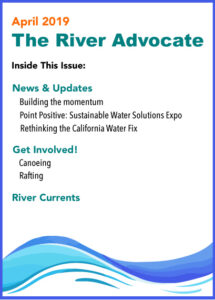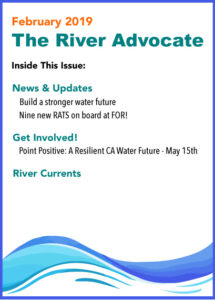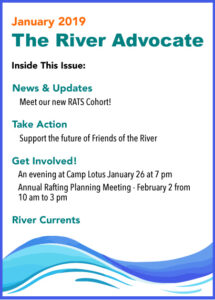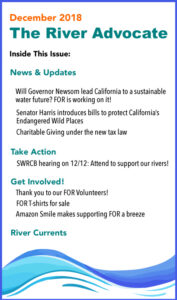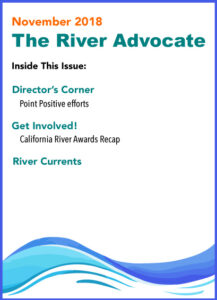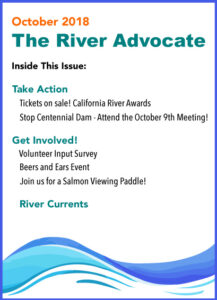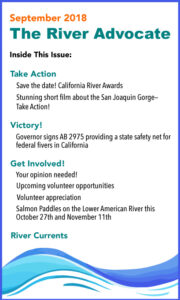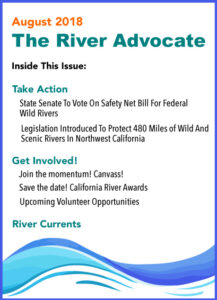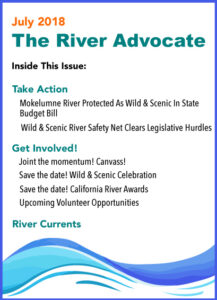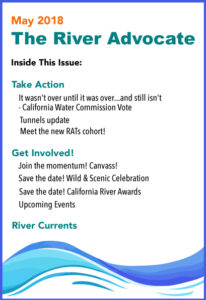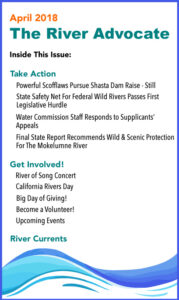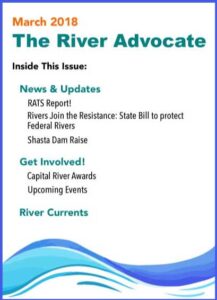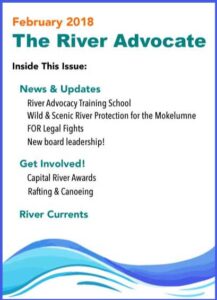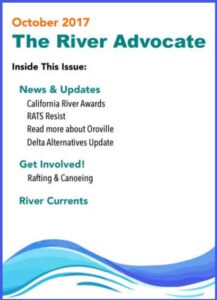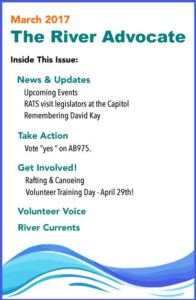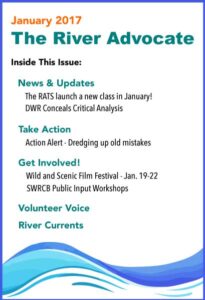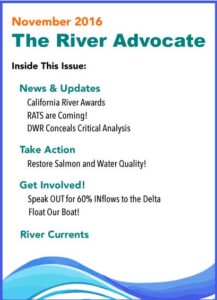In this issue:
- FOR 50th Anniversary
- Currents: Victories and Threats
- Newsom Executive Order a Water Grab
- Smith River Wild and Scenic Action
- Three bills threaten CA Rivers
- FOR litigation to Supreme Court?
- Del Puerto Canyon Dam Stumbles
- Sites Dam Water Availability
- Isabella Dam on the Kern River Ready for Snowpack
- FOR Asks US EPA to Not Fund Pacheco Dam
- Endangered Plant May Protect Endangered River
- Wild and Scenic River Anniversaries
February 2023
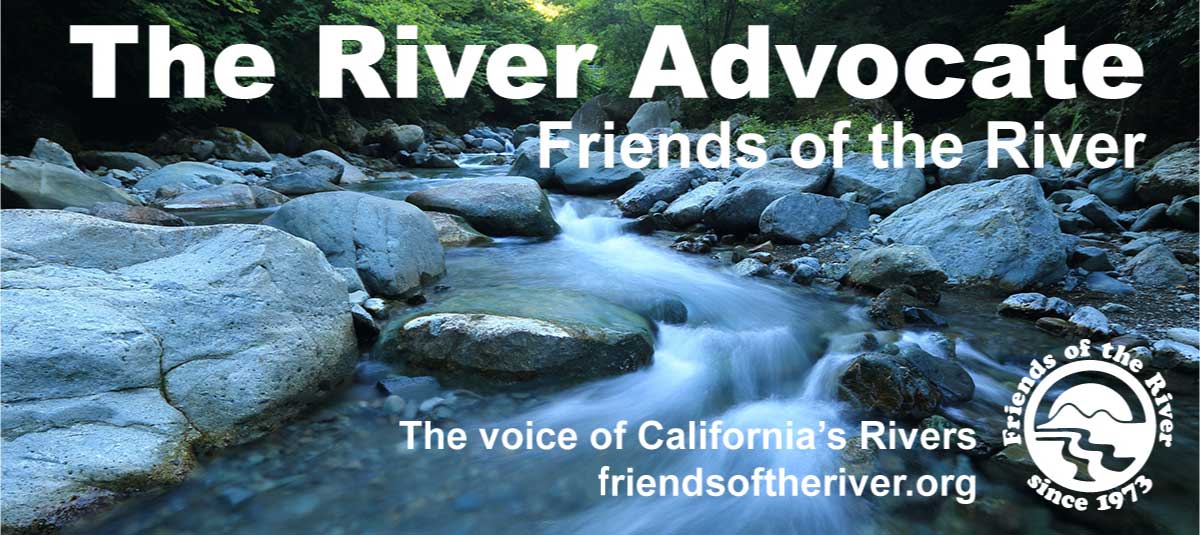
The Voice of California Rivers for 50 Years
by Jann Dorman, Executive Director

Friends of the River turns 50 this year. Fifty is a great age, old enough to have deep experience, but young enough to attract attention and still raise hell. FOR was born in 1973. The initiative organization for Proposition 17, (the initiative to save the Stanislaus), was given the name Friends of the River. Proposition 17 was tragically defeated in 1974 by a well-funded and deceptive campaign. However, over the decade Friends of the River grew into a formidable state-wide river organization and continued to fight for the Stanislaus and many other rivers, mobilizing thousands of people in letter writing, petitions, State Water Resources Control Board hearings, comments, and demonstrations. Throughout the 70s and early 80s, FOR continued the battle for the Stanislaus before the SWRCB opposing a myriad of “beneficial uses” to limit the filling of the reservoir and save the Camp 9 whitewater section. In 1979, as New Melones was filling, Mark Dubois chained himself to a rock and gave the world what may be the defining image of the environmental struggle of the 20th century.
Since inception, throughout the struggle for the Stanislaus and for all California rivers the next 50 years, FOR has led many campaigns for watersheds, rivers, dams, reservoirs and legislation. Following Mark’s example, FOR has faced adversity with courage and persistence. Throughout this year we will be honoring our past, and the intrepid individuals who, through their work with FOR, have helped shape the California watersheds we have today. We will also be engaging you in shaping the California we need tomorrow, the one with healthy rivers, and sustainable solutions to adapt to the changing climate.
We would like to invite you to two upcoming opportunities:
The California River Awards will take place on Friday, April 21, 2023 at the City Club of San Francisco. This gala event is FOR’s most important fundraiser. Please consider sponsoring the event, donating an auction item, purchasing an auction item on-line, and plan to join us for a wonderful evening with dinner and a live auction.
Guide Activist Training will take place on the American River, May 27 – June 4. This program is for those who would like to learn whitewater skills and volunteer for FOR. Participants of the 9-day program learn class 3 whitewater paddle boat skills along with river policy and advocacy. The program includes camping, meals and showers.
Please share these 2 events with your friends, families and colleagues. With your help, we can make a difference for rivers and for the climate.
Currents: Victories and Threats
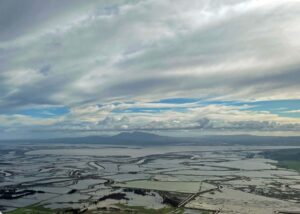
If not now, when?
Jann Dorman, Executive Director
This week, Gov. Newson issued an executive order (N-3-23) authorizing the State Water Board to ignore environmental laws and store additional water in the State’s reservoirs despite the fact that our snowpack is 200% of normal with more storms on the way.
This is a missed leadership opportunity. This year nature has provided historic amounts of rainfall and snow pack. The Governor and the State Water Board have the opportunity to share nature’s bounty with both people and the environment. Delta water quality standards protect drinking water for millions, as well as habitat for fish and wildlife. This year especially, there is plenty of water for people, agriculture, and the environment, while maintaining flow objectives and water quality standards consistent with law and the best available science. Leadership opportunities are like parenting opportunities. It means standing up for what is safe and healthy, and teaching how to share. It means doing the right thing.
John F. Kennedy said, “If not us, who? If not now, when?” The Bay-Delta ecosystem is collapsing and iconic species are going extinct. Every attempt should be made to uphold Delta flow objectives and water quality standards. There is no excuse to remove them — especially this year. Governor Newsom, do the right thing.
For more information, eloquent opinion, and analysis, please read this blog by California water expert Doug Obegi, and this article by Alastair Bland.
If at first you don’t succeed, try again
Ron Stork, Senior Policy Advocate
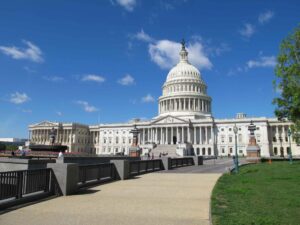
Since every Congress is a new Congress, one of the California-related wild & scenic river bills has been reintroduced. On January 31, 2023, Senators Merkley, Wyden, Feinstein, and Padilla reintroduced the Smith River National Recreation Area Expansion Act, a measure to expand wild & scenic river and NRA coverage of the Smith River into the state of Oregon (see map, bill text, bill summary).
At this writing, the other California wild & scenic river packages from the previous three Congresses have yet to be reintroduced. But stay tuned.
All these measures failed to achieve passage in the three previous Congresses — and will face even tougher sledding in the GOP-controlled House of Representatives than in previous years. But miracles have happened before.
Three proposed bills threaten California Rivers
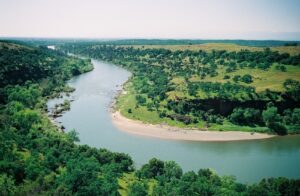
Keiko Mertz, Policy Director
We Californians are becoming all-too-familiar with the weather whiplash of extreme dry periods followed by torrential rains. This whiplash has caused angst amongst the public, water interests, and legislators, all seeking solutions to solve for drought and flood at the same time. Unfortunately, sustainable solutions are often passed over in favor of dams, which at a simple level may appear to solve the problem. However, adding more dams is not a holistic solution to California’s water woes for several key reasons. New dams are not equitable, are financially risky, and dams for storage have limitations for flood control.
New bills seek to add water storage and increase water deliveries in our parched golden state. Unfortunately, these efforts once again miss the point. As climate change exacerbates whiplash and reduces average snowpack in the state, 20th century water management will no longer work in the 21st century. Loud voices, along with bills like the ones described below, once again shift focus away from the real solutions: sustainable, natural solutions, and demand management.
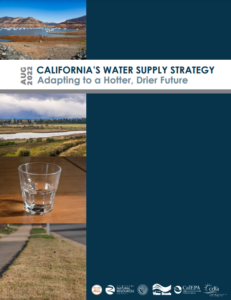
AB 62 Statewide water storage: expansion (Mathis R-Porterville) – This state bill seeks to add an additional 4 million acre-feet of water storage, both above and below-ground, in California in the next 17 years. That’s an increase of ~10% in the state’s water storage over a relatively short period of time — but perhaps only an increase in deliveries to farms and cities in the range of 1%. It directs the State Water Resources Control Board, in coordination with the Department of Water Resources to design and implement measures to increase storage to meet these goals: (1) 3,700,000 additional acre-feet by 2030, and (2) 4,000,000 by 2040. The agencies would have to begin progress reports to the legislature in 2027. To meet these timelines, projects will have to be fast-tracked, likely bypassing laws and regulations intended to protect people and the environment, with unmitigated environmental and social impacts likely. Neither will it come cheap. While FOR supports increasing sustainable water storage solutions, we are concerned when environmental protections are overlooked.
HR 289 Protect Our Water Rights (POWR) Act (LaMalfa R-Richvale) – Half of federal Central Valley Project (CVP) water is used in the Sacramento Valley, with the large majority high-priority agricultural water (settlement contracts). The remainder of the Sacramento Valley ag contracts are low priority — and can (and really must) be shorted dramatically during times of scarcity. This federal bill seeks, generally, to turn these low-priority contractors into higher priority contractors. Specifically, it attempts to assure that they receive 100% of contract allocations in “wet” and “above normal” water years, 75% in “below normal” water years, and 50% in “dry” and “critically dry” years. For reference, in 2022 (a “critically dry” year), these contractors received a 0% allocation, and municipalities received only 15% for health and safety needs. This simplistic allocation scheme would allow contractors to take more water than the sky delivers, compromising environmental flows needed for sustainability, and essentially gambling by taking the next year’s water to grow crops in the current.
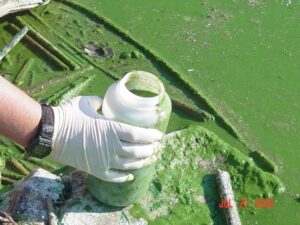
Equally egregious, under this bill, CVP contractors would also avoid their legally required operations and maintenance costs, handing them off to taxpayers instead. And lastly, the bill has provisions for Upper Klamath Lake (Oregon) that seek to prioritize water deliveries to Reclamation’s Klamath Project high-desert farmers from Klamath Lake rather than sharing obligations among Reclamation’s responsibilities to protect lake endangered species and the upper Klamath basin tribes. The lakebed and region, historically, was a vast network of wetlands supporting native species and countless migratory birds on the Pacific Flyway. These wetlands were drained for farming practices, and the lake currently captures nutrients from ag runoff, creating harmful algal blooms, choking native and endangered fish, and damaging Native American cultural resources. The region is rife with controversy over tribal rights and how to manage water for fish, fowl, and farms.
HR 215 Working to Advance Tangible and Effective Reforms (WATER) for California Act (Valadao R-Hanford) – Affectionately named the “Frankenstein Bill” at the FOR office, this federal bill is a hodge-podge wishlist by water interests related to water rights, deliveries, and projects in California. Some of the key wishes, summarized here, could have resounding impacts on California rivers and the ecosystems that depend on them.
- The bill would enable the illegal Shasta Dam raise project by freeing up federal funding for the project and attempting to override state law (the California Wild and Scenic Rivers Act).
- The bill seeks to override State sovereignty to manage State waters. The most egregious of these provisions is the attempt to prevent the state from curtailing any state water rights to balance Central Valley Project and State Water Project (state and federal water projects) impacts.
-
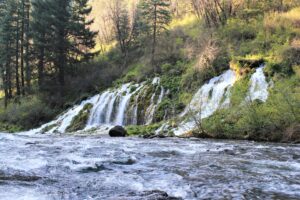
The McCloud River, endangered by Shasta Dam Raise. Photo courtesy of Tracey Diaz. The bill attempts to mandate use of the destructive Trump-era Biological Opinions (BiOps) for coordinated operations of the CVP and SWP, meaning looser regulations and less water for the environment. It also attempts to create more obstacles to update the BiOps, adding congressional approval as a requirement.
- The bill shares language with the POWR Act (above) for guaranteed allocations even in critically dry years. (Legislative sausage making is just that, since this provision should mean less deliveries to the sponsors’ southern San Joaquin Valley constituents).
- The bill attempts to cease legally-required Delta restoration aimed at restoring fisheries and ecosystems by September 2025 (the Central Valley Project Improvement Act).
A real devil’s wishlist.
FOR is closely tracking the progress of these bills, and opposing them. FOR will always advocate for nature-based, equitable, and resilient water solutions. These solutions include floodplain restoration (giving rivers room!), responsible flood managed aquifer recharge (restored groundwater!), ecological and functional flows, water recycling, and the elephant in the room: demand management. FOR will also continue to educate the public and lawmakers about how these proposed laws will impact California rivers.
FOR coalition litigation in defense of the Clean Water Act going to the U.S. Supreme Court?
Ron Stork, Senior Policy Advocate

Friends of the River (along with CSPA, the Sierra Club, SYRCL, and the Tuolumne River Trust) has been in a long-running legal struggle with the licensees of several federally licensed hydropower projects. These licensees have taken to the courts to reduce state authority (here, California, but these cases impact the nation) to protect and manage their waters. This previously-undisputed authority under the Federal Clean Water Act Section 401 empowers states to provide oversight to hydropower and other projects to protect water quality in the state. Timing is especially critical, since the states sometimes have only one opportunity per generation to prescribe requirements (a “water quality certification”) during renewal of a federal hydropower license. For some facilities, this means upcoming relicensings will be the first time major environmental laws are applied.
We’ve lamented over widespread success of the dam owners in escaping state water quality jurisdiction in previous the River Advocates under the accurate but the tongue-in-cheek moniker “the 401 apocalypse.” (Yes, the states losing their once-in-a-generation-or-two role in the decisions about non-federally owned dams would be bad for rivers, very bad.)
The dam owners attempted to subvert environmental obligations by taking advantage of a couple of lawsuits that threatened the state’s authority. A counter litigation strategy was needed. So, we took the combined Yuba, Bear, and Merced River case to the 9th Circuit federal court of appeals and played defense in the DC circuit court on the Tuolumne case, winning both cases last year (plus another case in the California Supreme Court). That was nice. But whether the game is over for the Nevada, Merced, Modesto, and Turlock Irrigation Districts and the Yuba Water Agency will depend on the decision by the U.S. Supreme Court on whether to take up their appeals.
Our attorneys (the Water & Power Law Group, the Western Environment Law Center, and the Morrison Foerster law firm) are sharpening their U.S. Supreme Court practice skills and alliances in preparation to respond.
Needless to say, our litigation budgets grow tighter as more legal work is done. Our work, here, has national consequences, and yes, donations to help fund the effort are tax deductible.
Proposed Del Puerto Canyon dam stumbles – at least a little
Ron Stork, Senior Policy Advocate
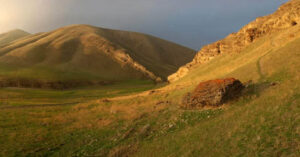
The Del Puerto Water District aspires to build an 84,000 acre-foot reservoir in the foothills just west of Patterson. However, the project stumbled some when it lost a lawsuit brought by Friends of the River, California Native Plant Society, Center for Biological Diversity, and the Sierra Club over its environmental impact report (EIR). The judgement, finalized last month in Stanislaus County Superior Court, was a narrow loss; the EIR did not examine road relocation alternatives and got a penalty foul as a result.
The environmental groups had raised more significant issues, such as the vague and conflicting operational plans to take federal Central Valley Project water from the Delta, divert it into the proposed reservoir, and then use the state and federal canals to deliver water to unknown customers in the south state. The Central Valley Project’s Friant Unit users had also raised issues about the impact of the project on their customers but also failed to gain any traction with the court, a court based well outside Friant’s south-eastern San Joaquin Valley service area.
The District is already working to cure the deficiency and has begun the preparation of a supplemental EIR while it and the plaintiffs weigh their appeal options.
The District has powerful allies to funnel money to the Del Puerto reservoir. Governor Newsom supports the project. The Trump and Biden Administrations have both offered money for the project in their budget proposals. Rep. Josh Harder (D-Tracy), who holds a seat on the U.S. House of Representative’s powerful Appropriations Committee, has steered taxpayer funds to the U.S. Bureau of Reclamation to assist in the $750 million project. And, the District is fishing for 25% federal funding of the project under the Water Infrastructure Improvements for the Nation Act of 2016 or last year’s bipartisan infrastructure bill.
The project is also fishing for state taxpayer subsidies. In the end, getting enough taxpayer subsidies and securing state water rights will likely determine whether this deadbeat dam will be built, so stay tuned.
Sites Dam offers an additional water availability analysis
Ron Stork, Senior Policy Advocate
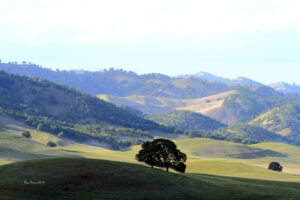
The trouble with trying to squeeze more water out of California’s rivers is that the juiciest sites were taken long ago. That fact has kept many of the remaining dam proposals relegated to the “deadbeat dam” category.
Last month, the proposed $3 billion 1.5 million acre-foot west-side Sacramento Valley reservoir provided the State Water Resources Control Board (Board) another water availability analysis in its quest for state water rights. Some scenarios projected that the reservoir had many years when it would be unable to capture much “excess” flow in the Sacramento River for diversion and subsequent sales to south state urban water districts.
It remains unknown whether the bean counters for the “investors” in the project can influence the politicians and general managers who make the decisions.
This project idea has lasted generations. It was even to be authorized in the defeated 1982 California Proposition 9 that would have authorized the Peripheral Canal around the California Delta (Governor Jerry Brown II’s twin tunnels and Governor Newsom’s tunnel were the successors to the Governor Brown I’s Peripheral Canal).
The wheels of the water rights process are beginning to turn. They are, along with the success of the project in harvesting taxpayer subsidies, likely to be decisive if this huge tap on the Sacramento River for the south state is to be defeated or at least somewhat successfully regulated. Again, stay tuned.
Isabella Dam on the Kern River gets ready to receive Sierra snowpack
Ron Stork, Senior Policy Advocate
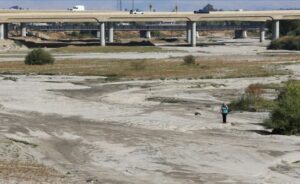
In recent years, the Army Corps of Engineers has been raising the height of its Isabella Dam, adding spillway capacity, and making major seismic safety improvements. The seismic concerns have also prompted interim operating restrictions to prevent filling the 565,000 acre-foot reservoir — something that the drought has taken care of naturally.
However, the project has progressed sufficiently for the Corps to seek permission from its headquarters to exceed the dam’s interim operating elevations in order to receive all or a portion of this year’s generous expected runoff. Runoff which might otherwise flow through the sandy and dry bed of the Kern River through Bakersfield – a wish of many Bakersfield citizens.
(The dam modifications are not increasing the dam’s water storage capacity. Doing so would displace considerable riverside private property in the 4.5-mile reach between the N.F. Kern national wild & scenic river and the top-of-reservoir bathtub ring.)
FOR asks the U.S. EPA to not bankroll the proposed Pacheco Dam
Ron Stork, Senior Policy Advocate
In a twist of perhaps cruel irony, the Congress saddled the U.S. Environmental Protection Agency (EPA) with the job of providing low-interest loans to construct dams around the country. The Santa Clara Valley Water District (Valley Water) is among the supplicants for such loans.
That gives citizens, of course, the option of offering advice to the EPA. So noting, among other matters, that Valley Water’s $2-billion-dollar or more Pacheco Dam would inundate a portion of Henry Coe State Park — in evident violation of state law — we suggested that the EPA decline Valley Water’s request.
Endangered plant may protect endangered river

Ron Stork, Senior Policy Advocate
It’s not common for a conspicuous but new-to-science shrub to be found in California, a well botanized state. But that’s what happened in 1992 with the discovery of the highly endemic Shasta snow wreath, Neviusia cliftonii, (Rosaceae, Kerrieae) growing around the shorelines of Shasta Reservoir.
But rare plant discoveries may have consequences. In 2015, The U.S. Fish & Wildlife Service (Service) reported that eleven of the twenty-four then-known populations would experience losses with the proposed expansion of Shasta Reservoir, and likely many others had already been extirpated by the reservoir.
The California Fish & Wildlife Commission made the species a candidate for endangered species status under the California Endangered Species Act in 2020, and this month fully listed. A petition for federal status is languishing with the Service.
Predictably, the U.S. Bureau of Reclamation’s November 2020 Shasta Dam raise supplemental Environmental Impact Statement was supremely indifferent to the status of the snow wreath (and other provisions of state and federal law), and recommended illegally expanding the Reservoir violating the California Wild & Scenic Rivers Act by inundating a portion of the McCloud River.
The dam raise is currently on hold pending a return of the executive and legislative branches of the U.S. federal government to GOP control.
February Wild and Scenic River Anniversaries
 Ron Stork, Senior Policy Advocate
Ron Stork, Senior Policy Advocate
California’s original wild and scenic rivers, Act III
Introduction: February is not a fertile month for wild & scenic river designation anniversaries. It’s more the season for bill introductions; so for this month, I continue the story of the rivers protected by the original California Wild & Scenic Rivers Act. Act 1 was the creation of the state designation and their inclusion within it. Act 2 was their nomination for, and acceptance into, the National Wild & Scenic Rivers System. Act 3 will describe whether they could withstand the legal challenges surrounding their inclusion in the national system.
 To tell the story of Act 3, I excerpt from an un-published memo from an eyewitness — the late (we believe) Jim Huddlestun, the former Rivers Programs Coordinator of the Heritage Conservation and Recreation Service (HCRS) and Former Regional Environmental Coordinator of the National Park Service (NPS) San Francisco, California Office. His memo recounts the fight in the courts to save Secretary of the Interior Cecil Andrus’s National Wild & Scenic Rivers Act Section 2(a)(ii) designation of California’s north coast rivers and portions of the American River.
To tell the story of Act 3, I excerpt from an un-published memo from an eyewitness — the late (we believe) Jim Huddlestun, the former Rivers Programs Coordinator of the Heritage Conservation and Recreation Service (HCRS) and Former Regional Environmental Coordinator of the National Park Service (NPS) San Francisco, California Office. His memo recounts the fight in the courts to save Secretary of the Interior Cecil Andrus’s National Wild & Scenic Rivers Act Section 2(a)(ii) designation of California’s north coast rivers and portions of the American River.
To refresh your memory, Section 2(a)(ii) of the National Act allows the Secretary of the Interior to add state wild & scenic rivers to the national system on the request of the governor of the state. Such rivers are to be managed by the state (mostly).
But now, in the fight to save the designation, the dramatis personae began to include lawyers.
What follows are slightly edited excerpts from Jim’s account:

January 1981: A restraining order, preventing Department of The Interior (DOI) Secretary Andrus from issuing a decision on the State of California’s application to place its wild and scenic river system in the National Wild and Scenic Rivers System, had been issued by federal Judge [William Austin] Ingram of the California Northern District earlier in the month. That order, based primarily on an alleged flaw in filing the final EIS but also raising questions on the adequacy of the EIS, was overturned by the U.S. 9th Circuit Court of Appeals on the late afternoon of January 19, the last [full] day of the Carter Administration. Secretary Andrus immediately signed the record of decision approving the state’s application. The basis for the 9th Circuit’s reversal appeared to be that the issue was not ripe for litigation in that a final action had not been taken. This was issued without prejudice and the matter was left open to further litigation.
1981, rest of the year: The plaintiffs immediately resumed the litigation but only Del Norte Co. remained with the water and timber interests. Trinity and Siskiyou counties withdrew. All outstanding cases were combined with Judge Ingram of the Northern District. As to the federal side of the defense, attorneys from the San Francisco offices of the U.S. Attorney and Interior Field Solicitor were replaced by attorneys from the Justice Department and the Interior Solicitor’s office in Washington. Bill Cohen became the lead attorney with Don Baur of the solicitor’s office assisting. This was perceived as keeping the case “close to the vest,” by the new [Reagan] administration, to perhaps affect the eventual outcome. However, as it eventually turned out, Both Bill and Don proved to be champions of the designation. Both O’Neill [HCRS’s then assistant regional director] and I proceeded to assist Bill in preparing briefs for the several court hearings that were to follow.
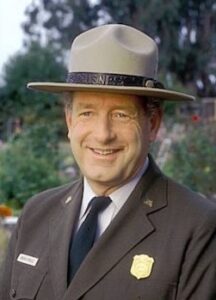

On February 19, Interior Secretary Watt announced the abolishment of HCRS and its functions and staff to be absorbed by NPS. On May 31, the transition was completed and the HCRS staff associated with the designation [were] scattered. Brian O’Neill became Assistant Superintendent [later Superintendent], Golden Gate NRA; Regional Director Dave Cherry became NPS Associate Regional Director for Resource Management and Planning. I retained my river program responsibilities, as did John Haubert in Washington DC, with NPS for the time being.
With the uncertainty over final disposition continuing, it was a challenge to address impacts from planned and proposed water development and land use projects. I retained review responsibility for these.
Later in the year, Judge Ingram moved his courtroom to San Jose and all his ensuing hearings on the case were conducted there.
1982: The state revised its wild and scenic rivers act by dropping the management plans requirement. This action addressed some of the legal challenges on the existing designation but may not have had a bearing on the outcome.

[Editor’s note: This revision was, in part, an attempt to make the state wild & scenic river system less compatible with the national wild and scenic rivers system in the hope that it might influence the court proceedings against the national designation. However, to attain passage, the legislation also contained language (§19 of AB 1349), that stated that it was not intended to affect the litigation. Such are the ways of law-making.]
In August, Roy Spradley, DOI Assistant Solicitor for Fish, Wildlife and Parks, requested a tour of the Klamath river in connection with his attending the American Bar Association convention in San Francisco. The tour was arranged through FWS [the U.S. Fish & Wildlife Service]. Dave Cherry and I picked up Spradley in Eureka and accompanied him on the tour. We ascended the river to Coon Creek Falls. Upon return to Eureka, we showed him video tapes of some of the other designated rivers that were made during the Nationwide River Inventory. We then drove him to San Francisco and on the way, took a side trip on the highway to Covelo along the Middle Fork Eel. We pointed out the site of the proposed Dos Rios dam, proceeded to the Round Valley overlook, and mentioned that the valley would be inundated with the project. The Dos Rios proposal was the most contentious issue on the designation from the water interests’ standpoint. Returning to the drive to San Francisco, I casually asked him what he thought would be the disposition of the 2(a)(ii) designation. He replied “oh, we’ll probably keep ’em” (whatever that meant).
 Additional court hearings were held during the year. These were to entertain arguments or rebuttals from both sides in the litigation. A final ruling was still pending. Meanwhile, agencies continued their business with the Klamath National Forest releasing its draft plan for public review. The Bureau of Land Management defined protective boundaries for their portion of the rivers—mostly on the Trinity. Reclamation conducted flow studies on the Lower American that evaluated different Folsom Dam release level impacts on fisheries and boating. Two of us from NPS and state agency representatives conducted on-site by-raft observations of the different flow-level effects.
Additional court hearings were held during the year. These were to entertain arguments or rebuttals from both sides in the litigation. A final ruling was still pending. Meanwhile, agencies continued their business with the Klamath National Forest releasing its draft plan for public review. The Bureau of Land Management defined protective boundaries for their portion of the rivers—mostly on the Trinity. Reclamation conducted flow studies on the Lower American that evaluated different Folsom Dam release level impacts on fisheries and boating. Two of us from NPS and state agency representatives conducted on-site by-raft observations of the different flow-level effects.
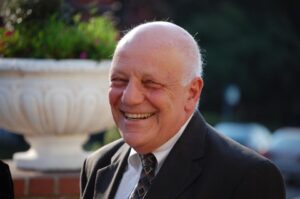
1983: In January, the Brown administration ended, and George Deukmejian became governor. The state’s position on the designation immediately changed with their withdrawal from the litigation and only leaving token representation by a Department of Water Resources (DWR) attorney.
The Environmental Defense Fund (EDF) [led by Tom Graff] joins as an intervener with the defendants and is granted standing in the case. This action would turn out to be a key to the final outcome.

That spring, a court hearing was scheduled that was expected to result in Judge Ingram’s final ruling on the case. On the day of the hearing, Bill Cohen and Don Baur arrived in my office and informed me that Asst. Solicitor Spradley was on his way carrying the state’s original 2(a)(ii) application. They speculated that with an anticipated adverse ruling on the designation expected, Spradley would return the application to the state’s attorneys. If a ruling was made requiring the Secretary of the Interior to remake the designation decision, the state would then simply withdraw its application. Spradley arrived in my office shortly after, and we held a brief conference without discussion of his mission. We then proceeded to San Jose with Cohen and Baur preferring to drive separately and leaving me to deliver Spradley and his briefcase (contents??) to the court. The matter was not discussed on the way down, but it was a hard pill to swallow knowing what I might be delivering.
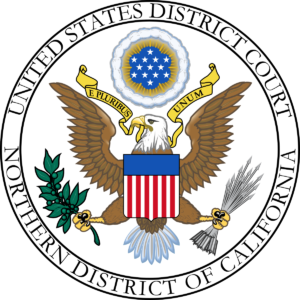 As expected, Judge Ingram overturned the decision, again citing the filing error and the lack of consideration of the state’s ability to manage, in accordance with the federal act, due to the failure to produce management plans in accordance with the [original] state act. He also ruled that adequacy of the EIS documents raised trial-able issues. With both the state and federal attorneys restricted on objections or appeal, EDF immediately requested a 30-day stay pending appeal to the 9th Circuit Court of Appeals. This was granted.
As expected, Judge Ingram overturned the decision, again citing the filing error and the lack of consideration of the state’s ability to manage, in accordance with the federal act, due to the failure to produce management plans in accordance with the [original] state act. He also ruled that adequacy of the EIS documents raised trial-able issues. With both the state and federal attorneys restricted on objections or appeal, EDF immediately requested a 30-day stay pending appeal to the 9th Circuit Court of Appeals. This was granted.

I was not aware as to whether or not the 2(a)(ii) was returned to the state pending outcome of the stay and possible appeal. We all returned separately to our home offices without further discussion.
On the 29th day of the 30-day stay, the 9th Circuit agreed to hear the appeal. The appeal is then argued and submitted, on November 16, before a three-judge panel in San Francisco. Meanwhile, the uncertainty continues with endless questions on whether the rivers are “in or out” coming from a variety of sources.
 1984: On May 11, the 9th Circuit announced its decision. The conclusions of Judge Ingram were soundly reversed. The appeals court held that the filing error was inconsequential to the final outcome, in that the plaintiffs had adequate time to review the FEIS, and noted that the plaintiffs used their own stalling tactics throughout the process in attempts to affect the outcome. They also ruled that the management abilities of the state were adequately addressed and that there appeared to be no trial-able issues with the remainder of the process. Upon this decision, the plaintiffs immediately filed a Writ of Certiorari with the U.S. Supreme Court.
1984: On May 11, the 9th Circuit announced its decision. The conclusions of Judge Ingram were soundly reversed. The appeals court held that the filing error was inconsequential to the final outcome, in that the plaintiffs had adequate time to review the FEIS, and noted that the plaintiffs used their own stalling tactics throughout the process in attempts to affect the outcome. They also ruled that the management abilities of the state were adequately addressed and that there appeared to be no trial-able issues with the remainder of the process. Upon this decision, the plaintiffs immediately filed a Writ of Certiorari with the U.S. Supreme Court.
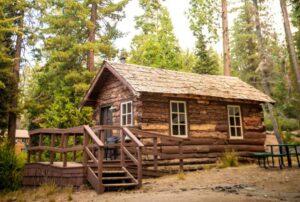
1985: On January 21, the U.S. Supreme Court announced that it would not hear the case, [in effect] thus upholding the 9th Circuit’s ruling of May, 1984.
Exactly four years and two days after the original designation decision, it was over. The “fat lady had finally sang” after a contentious period lasting nearly as long as some of the Wagnerian operas.
I was spending that night in Grant Grove [Sequoia National Park] working on an NPS development plan, having no access to telephone or TV. I heard the news on a poor reception battery radio. There was no one to celebrate with, and my celebratory scotch required icing with snow from outside, as guest services were at a minimum in the dead of winter.
Despite the litigation, change of administrations, and other efforts to invalidate the January 1981 designation, its survival would not have been possible without the draconian and workman like product that was required to make Secretary Andrus’s action possible.
The May 1984 9th Circuit’s ruling affirmed this and is a lasting tribute to the state Resources Agency and HCRS staffs that made it possible.
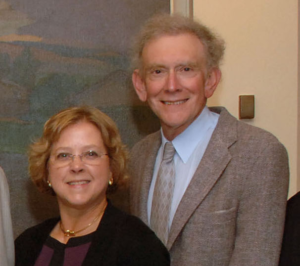
Postscript
Interpretive Sign: Barbara (Talley) McDonnell [from the state Resources Agency federal designation EIS team] had transferred to CAL TRANS after the end of the [first Jerry] Brown administration. She had information that her agency was planning to place interpretive signs along the Klamath River at the Collier rest stop on I-5 north of Yreka. With the designation now secured, she contacted me and together we designed a display commemorating the designation. It was placed, along with other interpretive displays on fish, wildlife and other natural features, in plain view of the river and easily accessible to patrons of this heavily used rest area. My last visit to the site, in 2003, revealed that the exhibits had been upgraded but the content of our original display had not been altered.
~~~~~Written by Jim Huddlestun, Vancouver, WA, October, 2011~~~~~
Post-postscript
Many of the individuals in this story, who heroically worked to ensure California Wild and Scenic Rivers were included in the National Wild and Scenic Rivers System, have passed away. The list includes Secretary Cecil Andrus (d. 2017) Don Baur (d. 2022), Tom Graff (d. 2009), Brian O’Neill (d. 2009), and Roy Spradley (d. 1998).
FOR is grateful for their hard work and dedication on these important designations.
River Advocate Back Issues
September 2022
Back Issues of Headwaters Newsletter

